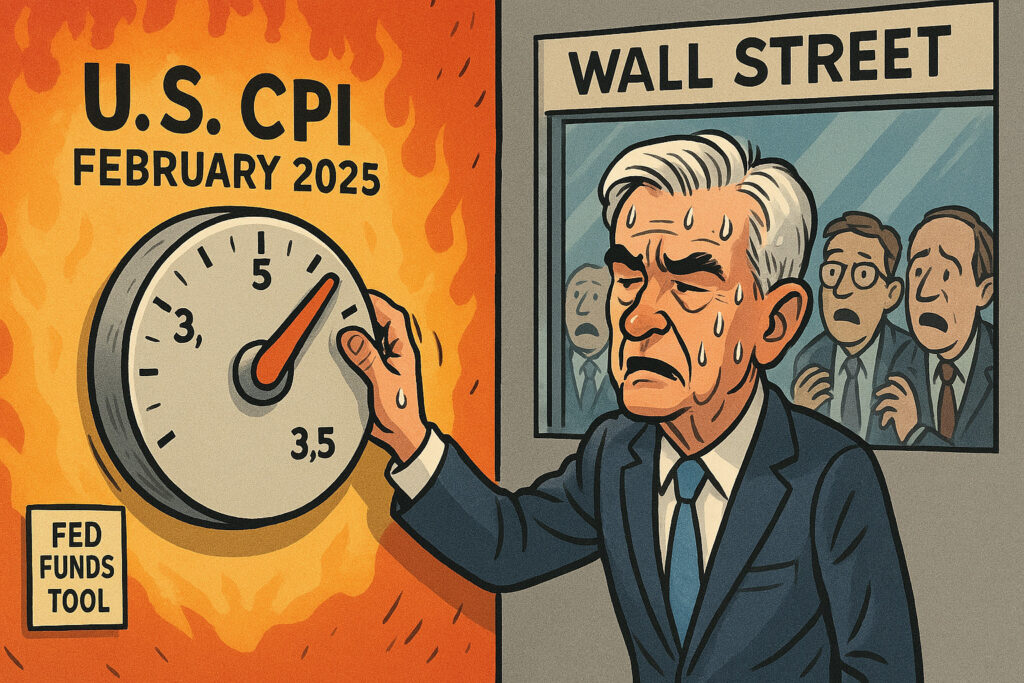Markets roiled as February inflation data comes in above forecasts, reigniting fears of further monetary tightening.
The U.S. financial markets were dealt a sharp dose of reality on Wednesday, March 12, as the latest Consumer Price Index (CPI) report for February came in hotter than economists expected, intensifying investor anxiety about the Federal Reserve’s next move on interest rates.
According to the Bureau of Labor Statistics, headline CPI rose 0.5% month-over-month, pushing the year-over-year inflation rate to 3.5%, well above the forecast of 3.2%. Core CPI—which strips out volatile food and energy components—climbed 0.4% on the month and 3.8% annually, also above consensus expectations of 3.6%.
This marks the second consecutive monthly surprise to the upside and is likely to disrupt the narrative that the Fed was done hiking rates. In fact, bond markets immediately responded, pricing in a 35% chance of a rate hike in May, up from just 10% before the data release.
Key CPI Components and Inflation Pressures
The inflation acceleration was broad-based. Energy prices jumped 2.2% on the month, driven by a rebound in gasoline prices. Shelter costs, which remain the largest component of core inflation, rose 0.6%, accounting for nearly 70% of the total increase in core CPI.
Notably, services inflation remains persistent, with airfare, car insurance, and medical care all contributing to the upward pressure. Goods inflation was more moderate, but price stickiness in rent and labor-intensive services continues to trouble policymakers.
Highlights from the CPI report:
- Energy: +2.2% MoM (gasoline +3.1%)
- Shelter: +0.6% MoM
- Food: +0.3% MoM
- Core CPI: +0.4% MoM / +3.8% YoY
Market Reaction: Bonds Sink, Stocks Wobble
Markets reacted swiftly to the data. U.S. Treasury yields spiked across the curve, with the 2-year yield jumping 13 bps to 4.92%, reflecting rising expectations of further tightening. The 10-year yield climbed to 4.34%, the highest in over a month.
Equity markets opened sharply lower, with the S&P 500 dropping 1.1% by midday and the Nasdaq Composite shedding 1.6% as tech stocks, which are especially sensitive to interest rate movements, bore the brunt of the selloff.
Asset price snapshot (as of 1:00 PM ET):
- S&P 500: 5,048.32 (-1.1%)
- Dow Jones Industrial Average: 38,091.24 (-0.6%)
- Nasdaq Composite: 15,775.91 (-1.6%)
- 10Y Treasury Yield: 4.34% (+11 bps)
- Dollar Index (DXY): 104.97 (+0.5%)
- Gold: $2,166/oz (-1.2%)
- Bitcoin: $67,200 (-2.8%)
Fed Dilemma: Patience or Preemption?
The hotter-than-expected CPI report puts the Federal Reserve in a challenging position. Just weeks ago, the market was pricing in multiple rate cuts in 2025, with the first anticipated as early as June. But the current inflation trajectory casts serious doubt on that path.
While Chair Jerome Powell has emphasized the importance of a data-dependent approach, the persistence of inflation—particularly in services and shelter—may force the Fed to reconsider its cautious stance. Futures markets now show just two cuts priced in for the year, down from five earlier this quarter.
In his latest speech, Powell remarked:
“We remain committed to returning inflation to 2%. If the data require it, we won’t hesitate to act.”
This statement, in the context of today’s CPI print, may be a prelude to a more hawkish pivot in the upcoming March 20th FOMC meeting, especially if next week’s PPI and retail sales data confirm sustained demand.
Global Impact and Dollar Dynamics
The stronger CPI report gave an immediate lift to the U.S. dollar, which gained ground against most major currencies. The EUR/USD pair fell to 1.085, while USD/JPY surged above 149.30, its highest since early February.
This dollar strength poses a new challenge for emerging markets and global equities, as tighter financial conditions could reverse recent inflows.
Inflation Expectations and Consumer Sentiment
The CPI data also threatens to shake inflation expectations. The University of Michigan’s preliminary March reading showed 1-year inflation expectations rising to 3.4% from 3.0%, signaling growing concern among households.
Consumer sentiment, which had been recovering steadily since the end of 2024, risks a reversal if inflation pressures continue to erode real purchasing power.
Sector Breakdown: Winners and Losers
Losers:
- Technology: Rate-sensitive, valuations compressed
- Consumer Discretionary: Squeezed by persistent inflation
- Utilities: Underperforming amid rising yields
Winners:
- Financials: Higher rates can boost margins
- Energy: Supported by rising oil and gas prices
- Dollar-sensitive exporters: Stronger USD benefits some global earnings
Forward Guidance: What to Watch
Looking ahead, investors and policymakers will closely monitor the following:
- March 14: Producer Price Index (PPI)
- March 15: Retail Sales (February)
- March 20: FOMC Decision & Dot Plot
- March 29: Core PCE Index (Fed’s preferred gauge)
If inflation shows no sign of retreating in upcoming data, the “higher for longer” narrative may regain dominance and reverse recent equity optimism.
Conclusion: A Hawkish March?
The March CPI report serves as a reality check for markets betting on imminent rate cuts. While one print doesn’t make a trend, the second consecutive upside surprise forces investors to reprice risk—and the Fed to potentially recalibrate.
Until inflation returns decisively toward 2%, any talk of easing may be premature. March 20 could mark a crucial turning point in the monetary policy cycle.
